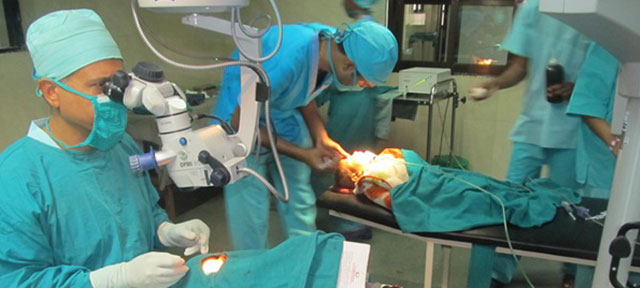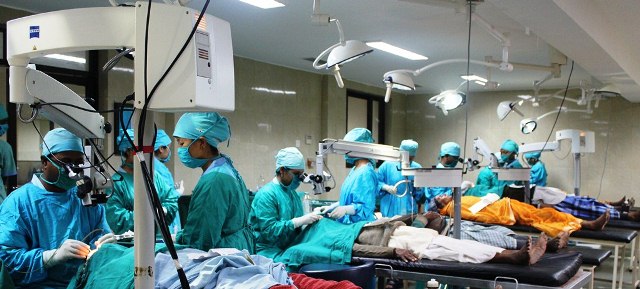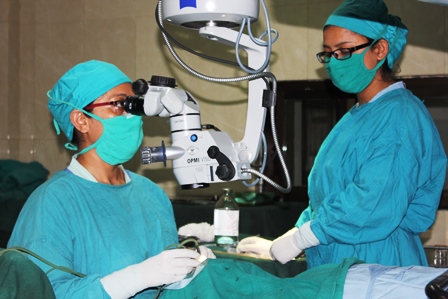Being a community based hospital our aim is to provide good quality and high volume service at an affordable cost. Patients requiring surgery can choose between different in-patient facilities with charges varying accordingly.
Eye operations are performed in the following facilities:
- 6 well equipped operation theatres
- 2 modular operation theatres
- 8 microscopes 4 with video facilities
- 6 Phacoemulsification units
- 3 sets of Vitrectomy unit with wide-angle viewing system (BIOM)
- ECG, pulse oxymetry and Boyle’s anesthesia machine for pediatric patients
- Cryo and laser unit
- 2 suction machines
- 2 ultra sound cleaner
- 2 air compressor
- 5 electric autoclaves
- 1 ETO sterilization
- EAR OT: Zeiss EBT Microscope for ear surgery, suction machine
- Modular OT for LASER EYE Surgery: Carl Zeiss Meditec AG’s MEL 90 Excimer Laser and Atlas Corneal Topography system
- Modular OT for Cataract Surgery: Carl Zeiss Meditec AG’s MEL 90 Excimer Laser and Atlas Corneal Topography system
Cataract Surgery (Adult)
- Small Incision Cataract Surgery (SICS) Fishhook Technique - Click here to Video
The cataract is removed manually through a small, self-sealing incision using a specially designed hook and an intraocular lens implanted. The small incision heals fast, allowing quick visual recovery. - Phacoemulsification - Click here to Video1 and Click here to Video2
The cataract is fragmented and emulsified using ultrasonic vibrations and aspirated. This requires only a very small incision, through which a foldable intraocular lens is inserted. This is the most advanced technique of cataract removal and allows faster and safer healing and visual recovery. - Zepto Phaco Surgery
- Biometry (Intraocular lens power measurement)
- Surgery: On the same or the day after admission
- Hospital stay: Overnight after surgery
- Local patients or those who want to go home are allowed to go immediately after surgery (they need to come next morning)
- Discharge: On the first post-operative day
- Post-operative medicines are given
- In bilateral cataracts, the other eye may be operated during the same hospital stay
- Patients are advised to return for follow-up: 6 weeks after surgery
Fee (NPR):
SICS with PC IOL – 1,200 & 4,000PHACO with PC IOL – 7,200
PHACO with Indian Foldable IOL – 10,000
PHACO with Foreign Foldable IOL – 25,000
Phaco with Indian Toric IOL - 30,000
Phaco with Foreign Toric IOL - 75,000
Phaco with Indian MF IDiff - 32,000
Phaco with Indian MF Acrydiff - 64,000
Phaco with Foreign Multi Focal - 110,000
Zepto Phaco with Indian Foldable – 40000
Zepto Phaco with Foreign Foldable - 55,000
Zepto Phaco with Indian Toric - 60,000
Zepto Phaco with Foreign Toric 105,000
Zepto Phaco with Indian Multifocal IDiff - 62,000
Zepto Phaco with Indian Multifocal Acrydiff - 94,000
Zepto Phaco with Foreign Multifocal 140,000
Cataract Surgery in Children (up to 15 yrs) Charge: NPR 8,000
Children with cataract should be operated as early as possible to enable normal visual development. The standard surgical procedure is extra capsular cataract extraction with primary posterior capsulorhexis, anterior vitrectomy & posterior chamber lens Implantation
- Biometry
- Surgery: One day after admission
- Bilateral cataract: Both eyes may be done during the same hospital stay
- Discharge: 3-4 days after surgery
- Required spectacles are provided
- Post-operative medicines are given
- Parents are advised to return with their children for Follow-up : 1, 3, 6, 12 months after surgery
Glaucoma Surgery
Surgery should be done as early as possible to prevent further deterioration of vision.
- Surgery: On the same or one day after admission
- Discharge: On the 2nd post operative day
- Post-operative medicines are given
- Patients are advised to return for follow-up : 3 weeks after surgery
Lacrimal Surgery
- Endoscopic Dacryocystorhinostomy (DCR)
- Dacryocystorhinostomy (DCR)
A passage is created between the lacrimal sac and the nose - Dacryocystectomy (DCT)
Removal of the lacrimal sac in toto - Surgery: One day after admission
- Discharge: On 2nd post-operative day
- Patients are advised to return for follow-up: 1 week after surgery
Corneal surgeries:
Refractive Surgery (LASIK/PRK)
DSEK
DMEK
DALK
TPK
Penetrating Keratoplasty
- On availability of donor cornea
- Discharge: On 2nd post-operative day
- Patients are advised to return for follow-up: 1 week or as advised

Autorotating Graft
- Admission: On Thursdays
- Discharge: On 2nd post operative day
- Patients are advised to return for follow-up: 1 week or as advised
Amniotic Membrane Transplantation
- Admission: On Thursdays
- Surgery: On Fridays
- Discharge: On first post-operative day
- Follow-up: After 2 weeks
PERFECT Surgery:
A special pterygium surgery (pterygium removal followed by conjunctival transplantation with fibrin glue) is performed on a regular basis.
Vitreo-Retinal Surgeries
Common Indication
Diabetic retinopathy, retinal detachment, bleeding within the vitreous cavity, macular hole, dislocated lens.
Retinal Detachment Surgery – Scleral buckle
This treatment involves placing a flexible band or silicone sponge (scleral buckle) around the eye to counteract the force pulling the retina out of place. It is often combined with draining the fluid under the detached retina, allowing the retina to settle back into its normal position against the back wall of the eye. Cryocoagulation is applied at the retinal tear.
Vitrectomy Surgery (PPV)
In a vitrectomy the vitreous gel, which is pulling on the retina and / or contains blood, is removed from the eye. Different forms of replacements are applied, like gas or silicone oil. The body’s own fluids will gradually replace a gas bubble. In case of oil a later surgical removal is needed.
- Surgery: Patient has to get the date for surgery and get admitted one day before surgery.
- Hospital stay: Most patients two days after surgery
- Discharge: On the second post-operative day
- Post-operative medicines are given
- Counselling: Special instructions on positioning after surgery is given (like face down, left side, right side) which should be followed strictly.
- Patients need to return for 1st follow-up: 2 weeks after surgery
- Further follow-ups are often needed over a longer time period









